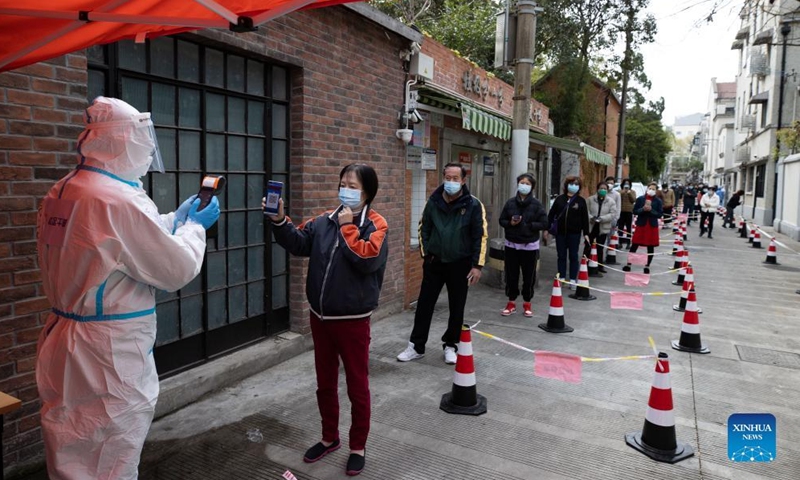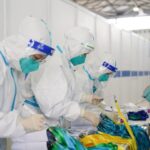Shanghai decided to conduct a city-wide COVID-19 antigen test on Sunday, and on Monday, city-wide nucleic acid testing will be conducted in a move to eliminate all risk points and break the transmission chain to curb the spread of the epidemic as soon as possible.
Conducting antigen tests aside from the nucleic acid tests could work as a way to detect positive cases faster and quarantine them sooner, Wu Qianyu, an official from Shanghai health authorities said on Sunday’s press briefing. Wu noted that over 10 million residents have received antigen test under the second phase of screening in Puxi, and some confirmed cases were detected.
Wu stressed that residents whose antigen test came back positive should report to their local communities immediately and remain at home to await a nucleic acid confirmation.

A community worker helps local residents register information before nucleic acid test in Changning district of East China’s Shanghai, April 1, 2022. Photo:Xinhua
The authorities can acquire the basic infection data and detect parts of the infection sources to prevent the transmission in a timely manner through the antigen test, which could lift the efficiency in detecting positive cases, Zhang Wenhong, head of the infectious disease department at Huashan Hospital in Shanghai said during a forum held online on Saturday.
Shanghai on Sunday reported 438 local confirmed coronavirus disease cases and 7,788 local asymptomatic infections.
The city has carried out a phased mass nucleic acid testing starting March 28 in Pudong and Puxi respectively, which are divided by the Huangpu River. Over 18.32 million nucleic acid samples have been collected in the latest rollout of mass screening from March 28 to 31 under the first phase of nucleic acid testing, while over 14.41 million residents have been screened so far in the second phase of screening since April 1. The second phase has scheduled for April 5.
Shanghai has established special working groups to coordinate the work related to nucleic acid testing, following Chinese Vice-Premier Sun Chunlan on Saturday urging Shanghai to make resolute and swift moves to curb the latest flare-up.
The dynamic adjustment in the process of sampling and testing should be strengthened amid this round of mass screening, in order to coordinate and take reasonable advantage of institutions’ testing capacities. Testing institutions need to report abnormal results immediately to health authorities, Shanghai authorities stressed on Sunday’s press briefing.
It is required to take the community as the unit, and a sampling point for every 2,000-3,000 residents will be set up; sufficient working staff including volunteers are required to maintain order to guide residents to keep 2 meters apart when receiving nucleic acid testing in batches, to avoid cross infections.
The first batch of samples should be transferred to the testing institution one hour later after sampling, and subsequent samples should be collected and transported every half hour to one hour, according to authorities.
Over 10 designated hospitals and makeshift hospitals have so far been earmarked in Shanghai, with several medical groups dispatched, according to authorities. The country has sent medical teams to help Shanghai to combat the outbreak; and medical staffs from some regions including East China’s Jiangsu, Zhejiang, and Anhui provinces have arrived in Shanghai.
A total of 2,000 medical staff from North China’s Tianjin will be dispatched to Shanghai in the fight against Omicron. Based on the national allocation standard of one doctor and five nurses in charge of every 100 patients in makeshift hospitals, 250 doctors and 1,250 nurses have departed from Tianjin to Shanghai on Sunday.
Along with medical assistance, other regions such as East China’s Jiangsu and Southwest China’s Sichuan Province have also sent vegetables and other daily commodities to Shanghai.
Nine COVID-19 patients have been discharged from a makeshift hospital in Shanghai on Sunday. The makeshift hospital was renovated temporarily in Shanghai World Expo Exhibition and Convention Center, which has accommodated over 7,100 mild and asymptomatic carriers.
A community worker helps local residents register information before nucleic acid test in Changning district of East China’s Shanghai, April 1, 2022. Photo:Xinhua




